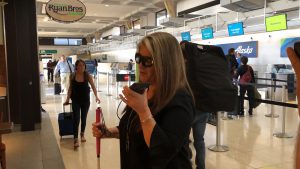New Technology Helps Blind and Low-Vision Travelers at San Diego Airport

Blind and low-vision travelers can now be more independent and navigate through the San Diego International Airport (SAN) with the help of new technology developed by a local start-up.
Using augmented reality, Aira connects people with visual impairments to a trained, live professional agent that provides on-demand assistance through smart glasses or mobile phone cameras. This greatly enhances independence and reduces the user’s reliance on airline personnel to complete pre-flight tasks, such as checking flight status, getting through security, identifying luggage, or finding restaurants and services.
“You can come to the airport and if you don’t have the app, you can download it here and subscribe and with a click of a button, and within seconds, you are connected to an Aira live agent and that agent can help you with any task you have at hand. You can do all the things people do at an airport, you can check in what gate is your flight, and what is the status of your flight, or maybe you want to get a drink or do some shopping, whatever that is, the agent can help you and guide you,” said Aira Chief Operating Officer Troy Otilio to La Prensa San Diego. “People that are blind or have low-vision can have a dog or a cane to go through the airport and they use that to guide them but those don’t tell you where to go, it doesn’t provide you with information.”
SAN offers the service free of charge to airport visitors. Other high profile businesses, retailers, airports, supermarket chains, campuses, and sport venues, also offer Aira service for free including UC San Diego and the San Diego Zoo.
“Today, if a blind or low-vision person asks for help at an airport, the airlines provide service but what they do, is they put you in a wheelchair like a disabled person, which means you’ll have to wait, it’s inconvenient, and it’s also a little demeaning. And with Aira, you don’t have to wait and sit in a wheelchair, you can walk in, and move in your own terms,” Otilio added.
Aira is also available as a monthly plan that allows users to access agents at any time and anywhere for a fee. It can be use for a variety of everyday activities including organizing and managing tasks at home, at work, or at school; reading inaccesible materials; travel and navigation; enhancing engagement with entertainment, events, and social gatherings; and troubleshooting technology.
Five years ago, Maria Johnson, a San Diego native, lost her vision completely, and used to struggle to get around before been an Aira user.
“Without this technology I’m still able to get around and do what I need to do, but a lot of times I needed to have a family member or a friend with me who could read things for me, or look something for me, and with Aira, now I don’t really need to have someone with me because they train agents, who can be with me at all times,” Johnson said. “I now have the confidence to go to a mall because I have someone with me through the app, before I wouldn’t go by myself or I would have to wait until someone could take me or go with me. So this technology has given me more freedom and confidence to be more independent as a blind woman.”


 Ana Gomez Salcido
Ana Gomez Salcido

